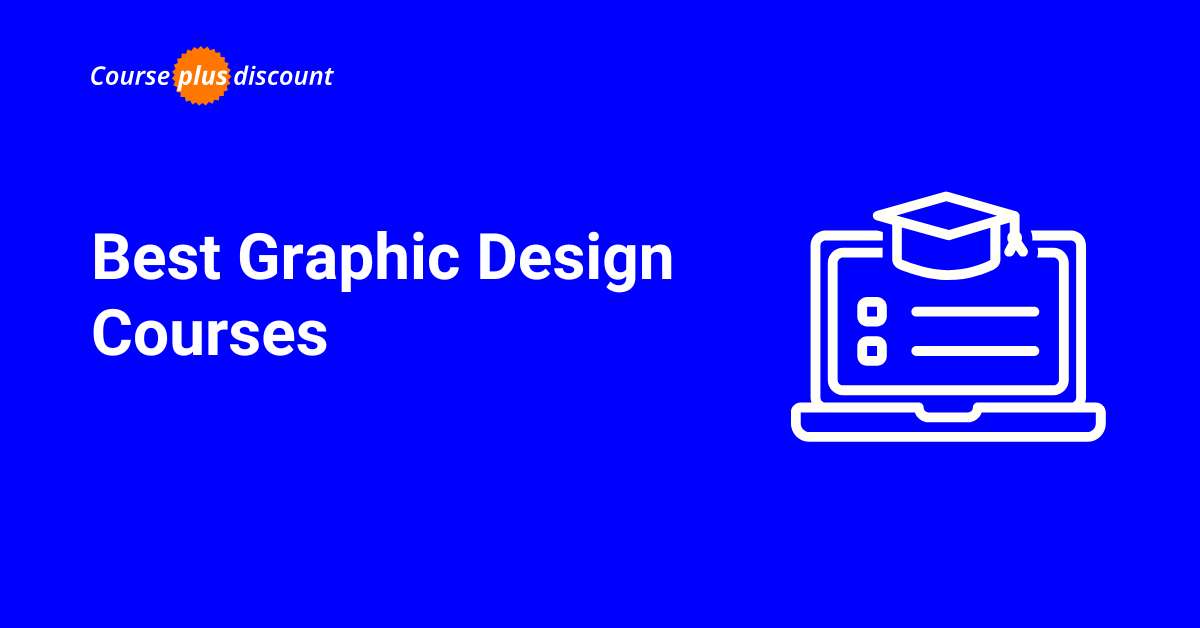Coursera’s Adobe Graphic Designer Professional Certificate and Designlab Design 101 stand out as the best graphic design courses for 2025, offering structured learning and career support.
The employment of graphic designers is expected to increase by 2% between 2023 and 2033, according to the Bureau of Labor Statistics; however, success depends on acquiring current skills.
The graphic design industry now requires the integration of AI, sustainable design practices, and remote collaboration alongside traditional design principles.
This guide breaks down the top courses, including real costs and career outcomes, to help you choose the proper training for your goals.
Top Free Graphic Design Courses With Certificates (2025 Updated)
Free courses offer excellent entry points for beginners and budget-conscious learners seeking to explore graphic design fundamentals.
These options provide structured learning paths without a financial commitment, making them ideal for testing your interest before investing in premium programs.
| Course Name | Platform | Duration | Certificate | Software Access | 2025 Updates |
|---|---|---|---|---|---|
| Canva Design School | Canva | 1-2 hours | Yes | Canva Pro trial | AI features added |
| Adobe Discover | Adobe | Self-paced | No | 7-day trial | New CC updates |
| Coursera Audit | Coursera | 4-6 weeks | Paid option | Limited | Updated content |
| Google UX Design | Coursera | 6 months | Yes | Figma free | Enhanced 2025 |
These courses represent different learning approaches, from quick tutorials to full programs. Each offers unique advantages depending on your time commitment and learning preferences.
1. Canva Design School
Canva Design School offers bite-sized lessons perfect for beginners wanting immediate results through interactive tutorials and step-by-step guidance.
The platform serves “more than 170 million people worldwide” according to Canva Newsroom, providing practical skills in social media design, presentations, and marketing materials with industry-standard templates.
The course includes access to Canva Pro features during the trial period, allowing students to experiment with premium elements and advanced functionality.
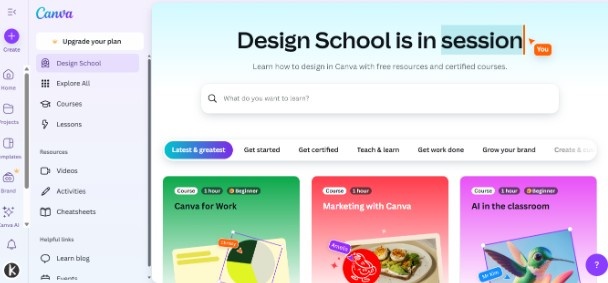
Canva’s strength lies in its user-friendly interface and practical applications for small business owners and content creators seeking quick design solutions.
2. Adobe Discover
Adobe Discover provides comprehensive introductions to Creative Cloud applications, including Photoshop, Illustrator, and InDesign, with hands-on project-based learning experiences.
While it doesn’t offer certificates, the hands-on experience with industry-standard software makes it valuable for serious learners seeking professional workflows. The program includes project-based learning with real-world applications, covering essential techniques used by professional designers worldwide.
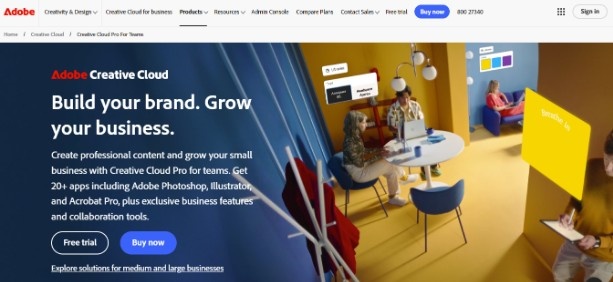
Adobe’s reputation in the design industry makes this course particularly valuable for understanding professional workflows and industry standards used by top agencies.
While this platform doesn’t provide a free course, however, a free trial is sufficient to gain the practical insights.
3. Coursera Audit Options
Coursera Audit Options allow free access to course content from top universities like CalArts and leading design institutions worldwide.
The Graphic Design Specialization from CalArts and Adobe Graphic Designer Professional Certificate are among the most popular choices, attracting thousands of students monthly. Students who want to explore free courses with certificates can find many options across different subjects on various platforms.
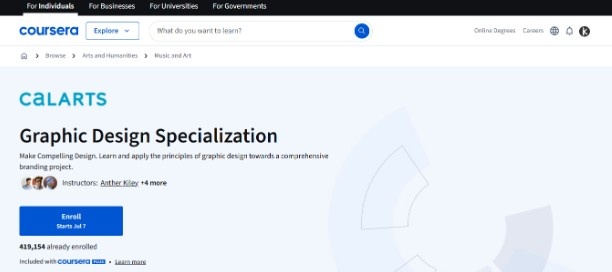
While certificates require payment, the course materials remain freely accessible, providing university-level education without financial barriers.
Coursera’s academic approach provides theoretical foundations alongside practical skills, making it ideal for comprehensive learning and professional credential building.
4. Google UX Design Certificate
Google UX Design Certificate includes graphic design fundamentals within its broader UX curriculum, covering visual hierarchy, typography, and color theory principles.
The program has become one of Coursera’s most popular offerings and offers direct pathways to employment opportunities with Google’s hiring partners. Like many other free Google certification courses, this program provides industry-recognized credentials without upfront costs.
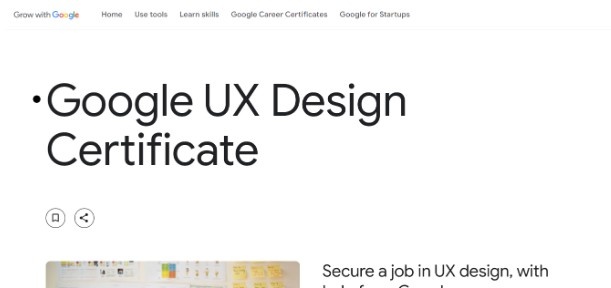
Google’s industry connections make this particularly valuable for career changers, with many certificate graduates reporting positive career outcomes within six months of completion.
Google’s reputation and job placement assistance make this course especially attractive for those seeking employment opportunities in tech companies and startups.
These free options provide solid foundations in design principles, software skills, and industry practices. They’re particularly valuable for exploring different specializations before committing to paid programs.
Best Paid Graphic Design Courses For Serious Learners
Premium courses offer structured curricula, personalized feedback, and career support services that justify their investment. These programs typically provide deeper learning experiences with industry mentorship and portfolio development guidance.
| Course | Platform | Price | Duration | ROI Score |
|---|---|---|---|---|
| Designlab Design 101 | Designlab | $499 | 4 weeks | 9/10 |
| Udemy Masterclass | Udemy | $159.99 | 30+ hours | 8/10 |
| Skillshare Premium | Skillshare | $168/year | Unlimited | 7/10 |
| CalArts Specialization | Coursera | $49/month | 5 months | 8.5/10 |
These courses offer structured learning paths with professional guidance and industry-recognized credentials. The ROI scores reflect career advancement potential and earning increases reported by graduates.
1. Designlab Design 101
Designlab Design 101 offers intensive mentorship with industry professionals from companies such as Google, Apple, and Nike. The course includes weekly one-on-one sessions and portfolio reviews.
Over 12,000 students have completed the program, with many reporting significant career advancement within six months of graduation.

Designlab’s personalized approach and industry connections make it exceptionally valuable for serious career changers seeking rapid skill development.
2. Udemy Masterclass
Udemy Masterclass offers extensive coverage of design fundamentals, typography, color theory, and software mastery.
The course includes 30+ hours of video content, practical projects, and lifetime access. With over 2,83,000 enrolled students, according to Udemy platform data, it maintains a 4.6-star rating from users.

Udemy’s self-paced format and affordable pricing make professional-level training accessible to budget-conscious learners worldwide.
3. Skillshare Premium
Skillshare Premium provides unlimited access to thousands of creative courses, including graphic design, illustration, and branding. The platform features classes from industry leaders like Aaron Draplin and Jessica Hische.
Monthly creative challenges foster community engagement and skill development among members. When comparing learning platforms, many students find that understanding the differences between Coursera vs Skillshare helps them choose the right fit for their learning style and budget.
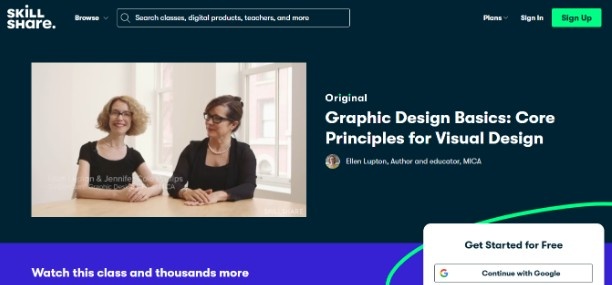
Skillshare’s creative community and diverse course selection make it an ideal platform for exploring multiple design disciplines and staying current with industry trends.
4. CalArts Specialization
CalArts Specialization offers university-level education from one of the world’s top design schools. The program teaches the principles of graphic design to create compelling design solutions, combining theory with hands-on projects.
Graduates receive certificates from the California Institute of the Arts according to the Coursera program details.

CalArts’ academic reputation and curriculum offer a strong foundation for professional graphic design careers.
These premium options deliver exceptional value through personalized feedback, industry connections, and structured learning paths that accelerate career development.
Platform-Specific Breakdown Of The Best Graphic Design Course
Different platforms excel in various aspects of graphic design education. Understanding each platform’s strengths helps you choose one that aligns with your learning style, career goals, and preferred interaction methods.
| Feature | Coursera | Udemy | Skillshare | LinkedIn Learning |
|---|---|---|---|---|
| Course Quality | University-backed | Mixed | Creator-focused | Professional |
| Pricing Model | Subscription | One-time | Subscription | Subscription |
| Certificates | Verified | Completion | Basic | Industry-recognized |
| Mobile Learning | Excellent | Good | Excellent | Excellent |
| Offline Access | Yes | Yes | Limited | Yes |
| Community | Moderate | Limited | Strong | Professional |
| Job Placement | Some programs | No | No | Strong |
Coursera emerges as the best overall platform for complete graphic design education. Its university partnerships, verified certificates, and structured learning paths provide the most professional credibility.
The platform’s career services and industry connections make it particularly valuable for serious learners seeking employment opportunities. Understanding Coursera certificates and their industry recognition can help you make informed decisions about your professional development.
How To Choose The Right Graphic Design Course In 2025
Selecting the appropriate course requires careful consideration of your current situation, goals, and learning preferences. The right choice depends on balancing multiple factors to find the best fit for your circumstances.
- Skill level assessment – Evaluate your current abilities honestly to choose beginner, intermediate, or advanced programs..
- Learning style preferences – Decide between self-paced flexibility or structured classroom-style guidance and deadlines.
- Budget considerations – Calculate total costs, including software, and calculate potential salary increases for ROI analysis..
- Career goals alignment – Choose specializations matching your desired path: freelance, agency, in-house, or specific industries.
- Time commitment – Set realistic expectations for daily/weekly study time and course completion timelines.
Success in graphic design education depends on matching course characteristics with your personal learning style and professional objectives. Consider starting with free courses to test interest before investing in premium programs.
Software-Specific Graphic Design Training (2025 Tools)
Modern graphic design requires proficiency in multiple software applications. Understanding which tools to prioritize helps focus your learning efforts on the most valuable and widely used industry applications.
- Adobe Creative Suite mastery paths – Focus on Photoshop for photo editing, Illustrator for vector graphics, InDesign for layouts, and emerging tools like Adobe Firefly for AI-powered design.
- Emerging tools gaining traction – Explore Figma for collaborative design, Procreate for digital illustration, and Canva for rapid prototyping and social media content..
- AI-powered design tools – Learn Midjourney for concept generation, Adobe Sensei for automated tasks, and ChatGPT for copywriting integration.
According to industry reports, the global generative AI in design market size is expected to reach USD 13,947.44 million by 2034, making AI literacy essential for future designers. Courses that include AI integration provide competitive advantages in the evolving design scenario.
What Modern Graphic Design Courses Must Include: 2025 Trends
Contemporary graphic design education must address current industry demands and emerging technologies. The best courses integrate traditional design principles with modern digital practices and evolving client expectations.
- AI integration and ethics – Understanding AI tools while maintaining creative authenticity and ethical considerations.
- Sustainable design principles – Learning eco-friendly practices and materials for environmentally conscious design solutions.
- Accessibility and inclusive design – Creating designs that work for diverse audiences, including disability considerations.
- Mobile-first design thinking – Prioritizing responsive design for smartphone and tablet consumption patterns.
- Cross-platform consistency – Maintaining brand identity across multiple digital and print media channels.
- Data visualization skills – Presenting complex information in clear, compelling visual formats.
- Remote collaboration tools – Mastering cloud-based design platforms and virtual team communication methods.
These skills ensure graduates remain relevant in an industry increasingly focused on social responsibility, technological integration, and global accessibility standards. As design intersects with digital marketing, many professionals also pursue Coursera digital marketing courses to enhance their comprehensive skill set.
Best Graphic Design Course: Expert Recommendations
Based on a comprehensive analysis of course quality, student outcomes, and industry recognition, these recommendations address different learning needs and career objectives.
Our top picks based on different needs:
- Best Overall Value – Coursera’s Adobe Graphic Designer Professional Certificate combines university-level education with industry recognition
- Best Free Option – Canva Design School for practical skills and immediate application opportunities
- Best for Beginners – Designlab Design 101 for personalized mentorship and structured learning progression
- Best for Software Mastery – Adobe Discover for comprehensive Creative Suite training and professional workflows
- Best for Career Change – Google UX Design Certificate for employment pathways and industry connections
These recommendations reflect a careful evaluation of curriculum quality, instructor expertise, student support services, and career advancement potential.
Also Checkout:
Conclusion: Find the Best Graphic Design Courses for 2025!
Coursera’s Adobe Graphic Designer Professional Certificate stands out as the best overall choice for graphic design education in 2025.
The combination of university-level instruction, industry-standard software training, and professional certification provides excellent value for serious learners. Budget-conscious beginners should start with free options, such as Canva Design School, before upgrading to premium programs.
The key to success lies in continuous learning and adapting to industry changes, particularly in the integration of AI and the adoption of sustainable design practices.
FAQs
Courses teach creative thinking, design principles, and AI tool integration that automated systems cannot replace in professional contexts.
Most students become job-ready within 3-6 months of dedicated study, depending on their prior experience and the intensity of the course.
Learn the fundamentals of Adobe Creative Suite first, then expand to specialized tools tailored to your career focus and industry requirements.
Employers prioritize portfolio quality and practical skills over credentials, though certificates from recognized institutions add credibility.
The median annual wage for design occupations was $53,180 in May 2024, according to the Bureau of Labor Statistics, with potential for higher earnings through specialization and experience.
